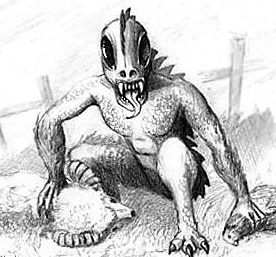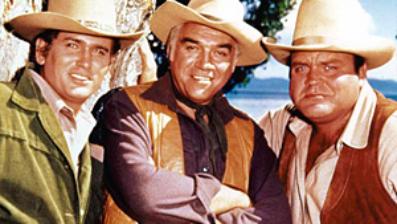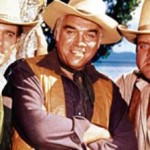“Bonanza” Creator Dies: Did He Also Create Chupacabras?
Posted by: Loren Coleman on September 8th, 2010

One of the significant items of note about the show “Bonanza,” in terms of cryptozoology, is that it was the first place on television that the term “Chupacabras” was used.
As I often tell patrons to the International Cryptozoology Museum, as opposed to “Chupacabras” being noted as a bloodsucker of goats throughout its history, the mention of “Chupacabras” by a Mexican farmhand on the series “Bonanza” was framed in terms of some kind of milksucker of goats in an episode broadcast in 1960. From milk to blood, it appears, the Chupacabras have changed their diet down through the years.

More research needs to be done to find a tape of that program, to discover if the creator of “Bonanza” also wrote that “Chupacabras” script, and discover as much as we can about that early broadcast.
In the meantime, news comes that the creator of the series has passed away.

David Dortort (above), 93, who created “Bonanza,” the top-rated Western that aired for 14 years on NBC with family values as its centerpiece, died September 5, 2010, in his apartment in Westwood.
David Dortort’s series was the most-watched from 1964-67. “Bonanza” ran from 1959-73, was the most-watched show on television from 1964-67 and maintained a place in the ratings top 10 for a decade. Dortort also created “The High Chaparral,” which originally followed “Bonanza” on Sunday nights on NBC and ran for three seasons.
In 1959, Dortort pitched his show to RCA subsidiary NBC. “Bonanza” would be filmed in color in gorgeous Lake Tahoe, Nev. — to help promote the sale of RCA’s color TVs — and feature a cast of relative unknowns (Michael Landon, Lorne Greene, Dan Blocker and Pernell Roberts) as members of the Cartwright family.
Dortort went away from the typical Western formula of focusing on lone drifters, choosing to focus on a family of three boys and a father living on the Ponderosa Ranch.
“Our scripts delve into character and deal with human relationships, which is where the best stories are. And we try to teach something about human values like faith and hope,” the Brooklyn native told Look magazine in 1965.
Bonanza premiered at 7:30 p.m. on a Saturday in September 1959 and failed to attract an audience going up against “Perry Mason” on CBS. But in fall 1961, NBC shifted the show to 9 p.m. Sundays, and it became a huge success.
“Bonanza” was canceled in 1973, a year after the beloved Blocker, who played Eric “Hoss” Cartwright, died unexpectedly after complications from gall bladder surgery. Dortort went on to produce several “Bonanza” spinoffs including “Bonanza: The Next Generation” (1988), a prequel for Pax TV and other Old West-based projects.

Before “Bonanza,” Dortort wrote episodes for such series as “Lassie,” “The Restless Gun,” “Climax!” and “Waterfront” and contributed to the screenplay for the 1952 Nicholas Ray film The Lusty Men.
A three-time Emmy nominee, he got his start as a producer on “Restless Gun.” Dortort served as president of the Producers Guild of America and was president of the Television-Radio branch of the WGA.
Dortort was married to Rose Dortort (b. New York city), who died Sept. 30, 2007 at age 92. Survivors include their children, daughter Wendy and son Fred, as well as brother Elliot and granddaughter Tracy.
A service will be held at noon Sunday at Mount Sinai Memorial Parks and Mortuaries in Los Angeles. In lieu of flowers, the family asks that donations be made to the Writers Guild Foundation and the Venice Family Clinic.
Sources of obit info: Hollywood Reporter and TV Guide.
About Loren Coleman
Loren Coleman is one of the world’s leading cryptozoologists, some say “the” leading living cryptozoologist. Certainly, he is acknowledged as the current living American researcher and writer who has most popularized cryptozoology in the late 20th and early 21st centuries.
Starting his fieldwork and investigations in 1960, after traveling and trekking extensively in pursuit of cryptozoological mysteries, Coleman began writing to share his experiences in 1969. An honorary member of Ivan T. Sanderson’s Society for the Investigation of the Unexplained in the 1970s, Coleman has been bestowed with similar honorary memberships of the North Idaho College Cryptozoology Club in 1983, and in subsequent years, that of the British Columbia Scientific Cryptozoology Club, CryptoSafari International, and other international organizations. He was also a Life Member and Benefactor of the International Society of Cryptozoology (now-defunct).
Loren Coleman’s daily blog, as a member of the Cryptomundo Team, served as an ongoing avenue of communication for the ever-growing body of cryptozoo news from 2005 through 2013. He returned as an infrequent contributor beginning Halloween week of 2015.
Coleman is the founder in 2003, and current director of the International Cryptozoology Museum in Portland, Maine.










It was in the episode where the boys go to mexico to pick up a prize bull for there father. A mexican famliy comes back with them and tells them about the whooperwill sucking the milk out of goats.
++++
Instant editorial comment/clarification by Loren Coleman:
The Whip-poor-will or Whippoorwill, Caprimulgus vociferus, is a medium-sized (22 –27 cm) nightjar from North and Central America. Another name for the whippoorwill in Spanish is chupacabras.
I doubt that the chupacabras of “Bonanza” has anything at all to do with the chupacabras as it is understood today. To me it seems pretty clear that the creature referred to in the “Bonanza” episode was merely a Whip-poor-will. There appears to have been a widespread belief in Latin America at one time(I don’t how prevalent it is today) that nightjars sucked goat’s milk.
Maybe it was a mistake? Nightjars in Spanish are referred as chotacabras, not chupa. According to Wikipedia, they are also referred as gallinaciegas, engañapastores or añaperos.
I have never heard the term chupacabras outside UFO/crypto circles. Chotacabras, on the other hand, is vaguely familiar. Then again, I’m a chilango city boy. 😉
Forgetomori dealt with these translation issues a few years back, here.
Who knows? “Bonanza” was HUGE in Mexico. Maybe it had also a big audience in Puerto Rico. Perhaps Scott Corrales could enlighten us on this matter?
Belief in milk-stealing critters are pretty prevalent worldwide. Everything from snakes to witches have been blamed for drying up goats and cows.
I have a feeling that chupacabras might be related to the Behinders of Appalachian folklore.
Does anyone else remember the episode that featured a dude traveling around in a wagon toting a frozen Minnesota iceman style body?
This is a commonly reported misperception. The episode in question is season 1 episode 16 entitiled “El Toro Grande”. The characters do not say Chupacabra, but instead chotocabra which, as noted by others, means Whippoorwill and is accompanied by the song of the bird in the scene.
Here’s a transcript.
The scene happens at the 31 minute mark of the episode and can be streamed online.
[From link above:
00:39:42 Oye, es la chotacabras.
00:39:44 Donde esta nuestro hijo?
00:39:46 Ay, san jose protegelo!
00:39:49 What’s the matter with your wife?
00:39:51 She have heard thechotacabras.
00:39:53 You know,chotacabras is those birds– — ..
00:39:59 Whippoorwill?
00:39:59 Whippoorwill, that’s right.
Craig]